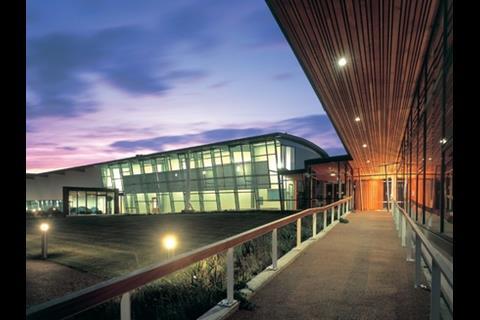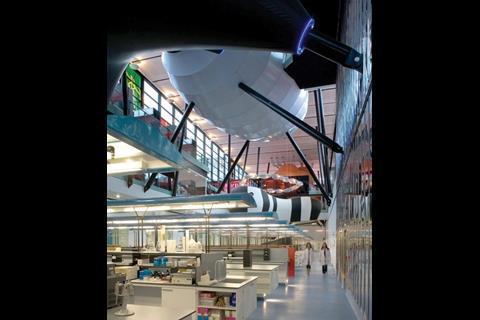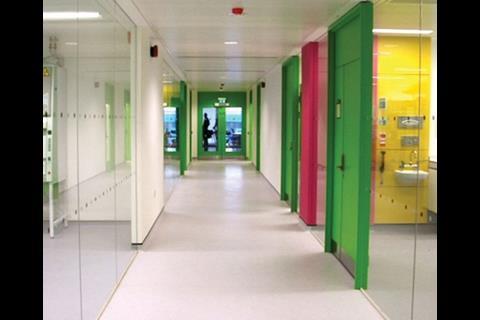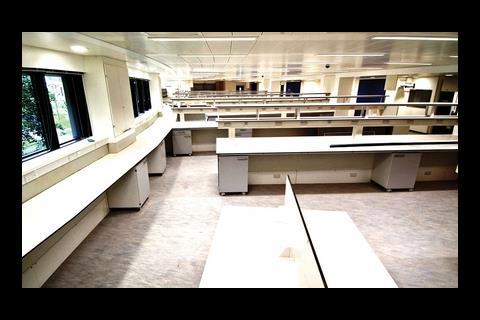Laboratories are probably the most demanding buildings that it is possible to build. Here, Simon Rawlinson of Davis Langdon examines the factors that their designers have to take into account, from the need to attract world-class talent to energy efficiency
01 Introduction
Research science has been in a state of continual evolution since the days of Galileo and Bacon, but the pace of change has accelerated in the 21st century thanks to innovations in areas such as genomics, nano-scale working and the introduction of mechanics-based disciplines into most fields of research.
These developments, which depend on multidisciplinary working, close environmental control and a wide range of highly specialised equipment, place a particular demand on buildings and the wider research infrastructure. Biomedical science is, along with information and communication technologies, one of the fastest growing sectors of the UK economy. Accordingly, the creation and maintenance of research hubs with sufficient critical mass to attract talent and funding is a key objective in national and regional planning.
Research is a truly global activity with huge investment by both the private and public sector in developed and emerging economies. In China for example, investment in government R&D is about £5bn a year, and is targeted to reach 2% of GDP by 2010.
Although global pharmaceutical companies and their research supply chains undertake a great deal of research activity, universities and their associated spin-off enterprises also comprise a significant element of the UK’s research capacity, and they need to be equipped to perform on the global stage. However, much of the UK’s research infrastructure dates back to the sixties.
Some of these facilities are operating beyond their economic life, and can act as a constraint on research activity in terms of ability to win research contracts, the nature of the experimental work that can be supported, the implementation of modern interdisciplinary working and the attraction of researchers who expect state-of-the-art facilities.
Since 1998, successive waves of public–private investment via the Joint Infrastructure Fund (JIF) and waves one to three of the Strategic Research Infrastructure Fund (SRIF), totalling £3.25bn, have supported the development of world-class facilities for UK universities. This has helped to address challenges such as:
- Changes in laboratory-based work, with a greater emphasis on physical sciences and engineering, which require fewer “wet” laboratories, but can require a high degree of environmental and vibration control, as well as degrees of security and containment. Changes in lab environments initiate change in the work that can be supported, so a typical new-build lab will involve new equipment and processes, and an important element of change management associated with working methods rather than the building itself
- Greater dependence on large-scale shared technology such as supercomputers or nuclear magnetic resonators. These facilities need significant supporting infrastructure and can only be afforded through pooling and sharing of resources and funding
- Greater specialisation and fragmentation of scientific knowledge. Collaboration is a necessity, not only because of cross-disciplinary research projects, but also because of the development of a large number of deeply specialised scientific disciplines.
- Requirements for flexibility and adaptability in planning and building services to deal with long and short-term changes in working practice. Much lab work in universities is related to fixed-term contracts that typically last two to three years, so it is valuable to have space that can be readily reconfigured in response to a project’s specific technical needs
- Supporting institutions in the global competition for talent. Design quality and the quality of facilities are seen by departmental managers as a key recruitment differentiator.
In addition to the significant technical and regulatory challenges that lab designers face, sustainability has emerged as an important theme. The driver has come from the US where many publicly-funded institutions are required to meet LEED standards (the US equivalent of BREEAM).
As laboratories can consume up to 10 times more energy than a typical office, designing and building a green lab is no mean feat. However the Lab21 programme in the UK is helping to widen the awareness of sustainability issues and the steps that can be taken to mitigate the impact of these buildings which, by necessity, use very large amounts of energy.
02 Key design issues
Research undertaken by the American laboratory journal R&D, has focused on the factors associated with lab design that have a direct effect on the work of researchers. Not surprisingly, quality of equipment and availability of technical resources top the wishlist, along with issues of safety, space allocation, flexibility and adaptability. From the perspective of clients, buildings that attract talent and funding, which blur the boundaries between research disciplines and facilitate collaborative exchange are also important. The practical implications for lab design of these requirements include:
- Laboratories are required to support increasingly technology-dependent research, based on complex computer modelling and process automation or robotics. Specialist equipment or processes may generate additional floor area requirements and could also place further demands on infrastructure such as high voltage supply capacity and resilience, stand-by generation and so on
- Environmental stability is, for physical and engineering-based sciences, as important a design criterion in support of statistically reproducible research as containment and security in the biological sciences. Requirements include clean-room standards of environmental stability for nano-tech work, together with the need to isolate instruments from vibration, electrical interference and so on. The challenge with environmental stability features is that they are an integral aspect of the building shell rather than the fit-out, and as a result can be difficult to retro-fit - even as a design change during the building contract
- Safety requirements are always high on the agenda because of the regulatory environment and the biological and radiation hazards associated with modern science. In practical terms, for dry labs, regulatory requirements are not as demanding as in healthcare, however, for procedures that introduce issues of bio-security, containment and user safety, they are the key drivers of projects, and require a structured approach to briefing and design based on analyses of workflow, hazards and so on
- Resilience and diversity of environmental control services and services supporting procedures are clearly vital to ensure experiments, some of which can take place over a long duration, are protected from risks of system failure and fluctuating environmental conditions.
03 Practical planning of laboratory facilities
Less than 50% of a typical laboratory worker’s time is spent in specialist laboratory workspace and there are many other workers – researchers, senior managers and support staff, for example – who will work outside of controlled laboratory conditions. Getting the balance right between research space, specialist and ancillary accommodation and all of the other support and circulation space required in a modern laboratory is important. There are further issues concerning adjacencies between lab space and write-up areas, and the need to create space that supports collaborative working.
Getting this right for projects that involve co-location, multidisciplinary working or the adoption of new technologies is even harder as the research processes used may change significantly as a result of the organisational changes and new capabilities that result from the capital project.
Successful planning should be based on a clear vision of the objectives and needs of the facility, as expressed in its business plan, an understanding of the processes and workflows used and an appreciation of the degree of reliability, flexibility and adaptability that will be required.
Once the initial plan is in place, there will follow a period of negotiation during which the priorities of end-user research clients and the university estates teams which commission and maintain space can be resolved and accommodated within the overall disciplines of project objectives, regulatory environment, institutional standards, budget and so on.
Among the main issues that need to be addressed during the early briefing and planning stage are:
- Confirmation of the planned research disciplines, which will determine the extent of specialist space requirements, degree of security, containment and isolation needed, as well as the extent to which collaboration space will be beneficial
- Definition of the research process workflow, including team sizes, processes, waste flows and so on
- Identification of specialist equipment and technology requirements
- Zoning uses with different servicing requirements, such as laboratories, write-up areas and equipment/preparation space so as to get the best use out of shared facilities and to allow for more effective control of different environmental conditions
- Determination of the balance of space use between primary (laboratories and write-up), secondary (preparation, equipment rooms and specialist facilities) and tertiary (meeting rooms and collaboration space) uses. These three categories of useable space typically equate to 65-70% of gross internal floor area, excluding plant rooms. These space requirements, together with required adjacencies and the chosen laboratory module, will have a significant impact on development efficiencies and overall building area
- Confirmation of the laboratory planning module. The research laboratory component of a laboratory building is planned on a regular grid, based on the width of partitions, depth of worktops and aisle space. Standard grid dimensions are used to size fit-out components. Depending on the discipline and, to an extent, the preference of the end user, modules can vary in width from about 3.1m to more than 3.6m, with the extra width in the aisle making it easier for researchers to share space effectively.
The grid determines the density of lab workstations in a building, together with the lateral dimension of the structural grid. Planning grids in labs are usually one dimensional, with the length being determined by the extent of equipment required, size of team and requirements for containment and security. Some laboratories are planned on a two-way grid which provides more options for the planning of the appropriate combination of lab and specialist space together with a regular module for “plug and play” services distribution, openings for risers and so on
- Agreeing the services distribution strategy
- Fixing the size of the labs themselves. Many researchers like the idea of small self-contained facilities, which also have the benefit of reducing the risks of contamination of experiments. However, labs accommodating eight to 12 researchers are a typical size for modern, multidisciplinary scientific research
- Confirming requirements for isolation solutions such as containment suites, clean rooms, robust structures, electromagnetic screening and so on. These facilities are typically provided to protect the integrity and statistical replicability of the experiment. In some cases a combination clean room and containment facility may be necessary to protect the laboratory worker, experiments and wider public
- Considering the impact of wider building constraints on the optimum layout of a laboratory. Principal issues include the overall permissible building height and floor-to-floor heights, which affect on-floor servicing options, and the depth of floor plates that can be accommodated. Floor plate depth affects the way in which laboratories, write up areas, support space and circulation are arranged. If the right combination of spaces cannot be provided on floor plates to suit the needs of end users it can have a significant impact on development efficiency and adjacencies.
04 Servicing strategies for laboratories
Laboratories are among the most energy intensive of buildings. In a typical research university, although laboratories account for only 10% of the space, they can consume up to 30% of the energy used. The prime reason for this relates to mechanical ventilation, as laboratories typically operate on a five-air-changes-an-hour basis, with specialist areas needing 10 air changes an hour. Laboratories often run 24/7, resulting in a very high level of energy consumption. Growing dependence on high-end computing and other equipment also means electrical “plug loads” have risen. With the adoption of technologies such as blade servers, which provide fast IT infrastructure, cooling loads are rising, too.
Environmental stability is a key criterion for scientists who have to arrive at statistically reproducible results. As lab work involves an increasing element of mechanics and high-precision assembly work, other aspects of environmental control including the control of high volumes of fresh air with laminar air flows, supply of process water within narrow tolerances and the close control of temperature and humidity fluctuation have to be addressed. This requires larger air volumes, risers and service voids, and high plant capacity in heating, cooling and dehumidification.
Against the natural desire of the end-user to have the best of everything, university estates team are concerned with procuring buildings that are reliable and easy to maintain and adapt using an estate-wide facilities management resource. As a result there is a need for reconciliation between the needs of the two client bodies.
Approaches that are adopted to optimise initial and operating cost and to provide for long-term flexibility and adaptability include:
- Distribution and control strategies using dedicated systems that enable conditions including temperature, humidity and negative pressure to be maintained in lab and technical spaces. Write-up and other support space can be ventilated conventionally
- Adoption of modular approaches to the design of ductwork and principal risers, so that systems can be readily adapted and additional capacity introduced. For total flexibility, above-ceiling interstitial service levels are preferred as they permit total distribution flexibility and enable all maintenance work to be done outside of the lab. Interstitial floors typically need a floor-to-floor height of about 5m. If cost or planning constraints mean this dimension cannot be accommodated, the ceiling void can be reduced, or a “side-stitial” arrangement (that is, running major vertical ducts with a dedicated service zone on one side of the lab) may be the best solution, even though views and natural light may be reduced by the arrangement
- Location of high supply and extract loads, such as laboratories with fume cupboards, close to roof level to minimise the length of duct runs and fan loads
- Use of large-cross-section ducts to reduce fan loads and air pressure drops. This approach requires larger plant rooms, ducts and service voids but can make a considerable contribution to reducing operating costs
- Specifying building services plant prescriptively, so that the facilities management supply chain can be rationalised, and so long-term partnerships can form with a two-way exchange of knowledge
- Specifying “reduced energy” lab equipment such as variable air volume fume cupboards.
05 Sustainability and laboratory design
Green issues have become important in lab design owing to the growing awareness of the potential for excessive energy consumption, resulting from assumptions made during design concerning equipment performance and in-use building management. Lab buildings, like many others, are required to comply with sustainability standards such as BREEAM, although a bespoke scoring system is required. In some cases schemes are also expected to source a proportion of their energy consumption from renewable resources in accordance with the Merton rule.
Specific aspects of lab operation make sustainability objectives difficult to pursue, including the impact of safety margins and experimental conditions, high volumes of air and water usage, and limits on energy reclaim and recirculation owing to cross-contamination issues. Although some equipment consumes high levels of energy – a single fume cupboard operating at a constant volume consumes as much power as three households – there are a number of areas where patterns of use and specification can be challenged. An initiative, termed Labs21, has identified the following opportunities for low-energy use, based on principles of engineering-led design, which is focused on sizing to meet actual loads and the ability to match supply with demand as it fluctuates:
• Proper integration of subsystems based on a modular services infrastructure. “Plug and play” systems such as these, based on a fully accessible distribution network, have high initial costs but allow for easy, low-cost adaptation and effective system configuration
• Concentrating extreme loads in specified areas through careful process flow design and space planning.
• Thorough testing and justification of end-user requirements for specific environmental conditions. Basing the engineering on actual loads rather than manufacturer’s recommendations helps to match supply to demand and prevents “overdesign” based on worse case scenarios
• Adoption of deliberate low energy strategies including:
- Variable air volume systems in laboratories and fume cupboards
- Low-pressure-drop ductwork
- Separation of ventilation systems to enable air-recirculation and heat reclaim where safe to do so
- Use of modular plant to achieve high efficiency during extended periods of operation.
06 Cost drivers
These are the main design variables with affect cost:
- The type and mix of science determines the degree of environmental control and containment required in lab spaces, together with the range of specialist and shared equipment and facilities required to support the research task. These requirements will have a direct impact on the cost of additional floor area or lab fit out and equipment. There is also the potential for indirect additional cost related to extra plant and riser space for dedicated air-handling systems, the capacity of ventilation systems to deal with high air volumes and so on
- Plant room allocations. Depending on the number of separate systems required, plant room space will add more than 20% to the net floor area of the building. This is in addition to floor area occupied by risers, and access space such as interstitial floors or sidestitial walkways
- Accommodating new equipment, which can potentially introduce new technical requirements into the base build brief
- Special requirements in technical spaces, which may have a direct impact on the design of the building shell. For example, vibration isolation is dependent on the use of massive structures in specialist spaces
- Investment in futureproofing, which is in part concerned with the ability to adapt to project-specific requirements with minimal disruption, but is also concerned with providing the infrastructure to accommodate the development of science during the life of the building.
Futureproofing is a matter of degree but will be concerned with providing sufficient space, building integrity and services capacity to accommodate foreseeable and unforseeable needs. Flexibility requirements also affect the design and specification of lab furniture
- Requirements for diversity and security of supply, aimed at preserving the integrity of experiments and ensuring that control over potentially hazardous processes is not compromised
- Location of specialist spaces. Short service runs help to minimise pressure drops, and require less duct space. Constraints on lab planning which require long or complex services routes will increase cost
- Extent of co-location and multidisciplinary working, which has the potential to affect the extent of tertiary and balance space needed in order to create an environment for effective teamwork and exchange of ideas
• Lab servicing strategy, which covers the following key issues:
- Access to on-floor distribution. The ability to maintain and reconfigure services outside of the lab space is valuable to users but comes at a price. Interstitial floors provide the best access but require greater floor-to-floor heights, walk-on ceilings and such like. Sidestitial can be accommodated within a conventional floor-to-floor height but access provision takes up useable floor area
- Density of on-floor services. Some commercial labs with interstitial floors adopt a “flood” approach to servicing, based on a repeated 3m module across a wide range of space, enabling space to be switched between write-up areas and labs. This results in a high initial costs, but a high degree of low-cost future adaptability. Alternative approaches vary to the extent that spare capacity is provided for in the initial distribution scheme, ease of access and so on
- Extent of centralised provision. Central, universal provision of compressed air, gases and so on adds cost. An alternative approach is to supply gas locally using cylinder storage. This will in turn require storage space within an individual lab space plan
- Extent of modular lab fit-out
- Structural grid, combined with requirements for structural openings, constraints on allowable vibration and so on.
07 Reseach lab case study
The cost model breakdown (overleaf) is based on a university-funded research laboratory. The building has a gross floor area of 12,600m2, of which 5,750m2 is laboratory and technical space, and a further 3,200m2 is write-up, office and collaboration space.
Services distribution to laboratory areas is by a sidestitial strategy. Low energy features in the building include displacement ventilation and use of exposed soffits in write-up areas.
Rates are appropriate for a design and build contract procured on the basis of a two-stage tender.
An allowance for the contractor’s pre-construction services is included in the breakdown. Rates are current in the first quarter of 2008, based on an outer London location.
The costs include the full fit-out of laboratory and technical areas, including IT infrastructure. Loose fittings and equipment are excluded from the costs. Also excluded are the costs of site preparation, external services and external works, professional fees, client’s management costs and VAT.
Costs can be adjusted using the location factors provided. Site conditions and constraints, project size, programme and procurement route should be considered.
08 Cost breakdown
(See file attached).
09 Acknowledgements
Davis Langdon would like to thank Steve Howie and Kieran McDaid of Imperial College, Neville Surti and Catherine Nikolaou of Sheppard Robson and Chris Boyce and Mark Halstead of Davis Langdon for their help in producting this cost model.
Downloads
Cost breakdown
Other, Size 0 kb




























No comments yet